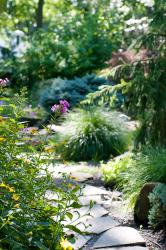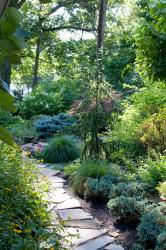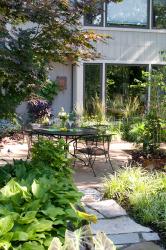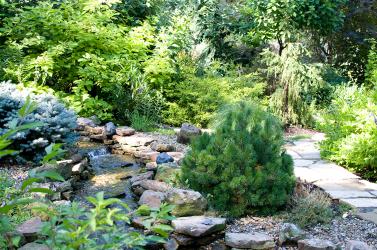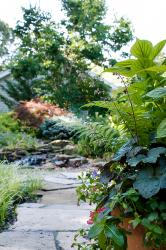When she began designing her own garden, Betsy was well up to the task. Describing herself as someone who had previously “putzed around” with gardening when her children, now 22 and 24, were small, Betsy got serious 10 years ago. She took the Master Gardener course at the Missouri Botanical Garden, offered through the University of Missouri Extension Service. Following the completion of the course, she began working at Garden Heights Nursery in Richmond Heights, and immediately “hit it off” with a coworker, Caroline Hogg. The two women became instant friends and decided to pool their knowledge. They created a company called The Artful Garden, specializing in garden design, construction, installation and maintenance. “We decided to try something we both loved,” Betsy explains simply.
Her own landscaping concept gave Betsy the joy of using plants she already knew she loved while adding a new-found favorite evergreens, which require no maintenance. She planted weeping Alaskan cedars for their vertical height to 15 feet and architectural interest, created by unusual branching. “They have so much character,” she says.
For contrasting shape and intense blue color, she added a number of dwarf “Blue Globe” spruce, which she keeps trimmed to encourage the round shape and low height. “Lemon Thread” false cypress got the nod for its chartreuse color and feathery texture, particularly in contrast with the blue spruce. She included a dwarf mugo pine for its rich, dark-green color and mounded shape.
She also made liberal use of another favorite, “Garden Glow” dogwood. Featuring bright chartreuse leaves in summer, this shrub-size plant has delicate, frothy-white flowers in spring and red stems that brighten up the winter landscape. “It works both in the sun and shade, but prefers partial shade,” she notes.
While she loves most hydrangeas, “Annabelle,” a native hydrangea discovered growing in Anna, IL, is particularly suited to her rustic garden, and she loves its huge white blossoms and long bloom time. Because they bloom on new wood, homeowners often are counseled to cut their “Annabelles” down in late winter. “I’ve tried cutting them back and letting them go, and I don’t think it makes any difference in the blossoms,” she says.
When it comes to grasses, she is partial to “Karl Foerster,” also known as feather reed grass. It is dramatic in the landscape both for its vertical height to 5 feet and its wheat-colored seed heads, which she particularly likes as a contrast with surrounding evergreens. “It is one of the few grasses that can handle both wet and dry conditions,” she adds.
Both in her own garden and when working with clients, Betsy concentrates on unfussy plants with an “easy-to-grow” reputation. In addition to stalwarts such as “Lemon Thread” false cypress and “Garden Glow” dogwood in the landscape, Betsy notes, she is able to clip something from her garden to decorate her home 12 months a year.
To enhance the rustic feeling of the landscape, the flagstone path through the garden meanders back and forth among the shrubs and trees. Rock outcroppings and patches of gravel add to the mountain theme. While Betsy herself has transformed her space by planting the shrubs and trees, Mark Couch of Woodland Gardens built the creek that flows in and around the plants. Both have recreated the Wendell’s desired vacation experience. “Sitting on the porch, we can hear the sound of the water and we usually can’t see a neighbor’s house,” Betsy says.
She loves gardening, she explains, because she finds it therapeutic. “I like to be outside, and I don’t sit well. I love being surrounded by a garden and looking at things that are pretty.”
In working with her customers, Betsy has observed some common mistakes people make in their own gardens and has some tips.
• One mistake is putting in too many single things. When you do that, a garden always looks like a jumble. We always try to use multiples of odd numbers of plants.
• Another is going to a nursery and picking out a beautiful blooming plant because it looks so pretty, then getting home and trying to find a place for it. You can mess up a whole area just trying to find space for that one plant.
• Do not be afraid to move plants around until you find a spot they like.
• Get rid of high-maintenance and invasive plants.
• Spotting containers of annuals in the landscape can add height and variety.
• Be cautious about new varieties of plants. Often they have not been tested for the long term. Some really do not do well when they first come out. Often it is better to stick with tried-and-true varieties you know work.
• If you want a shrub to stay small, make sure you have planted a slow-growing variety and then do not be afraid to trim it back.
Resources
Garden design: The Artful Garden, 314-614-7819
Creek/water feature: Woodland Gardens, 314-920-9554


